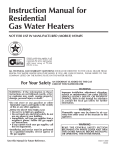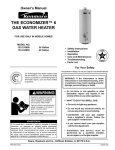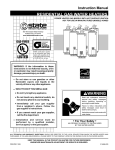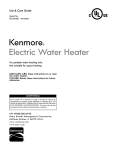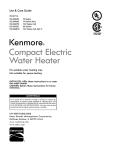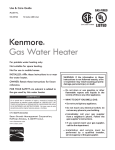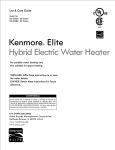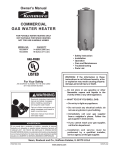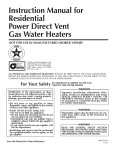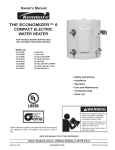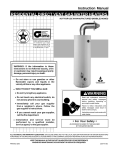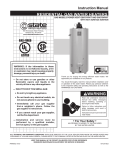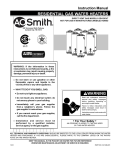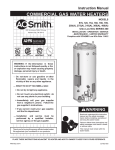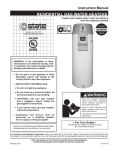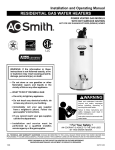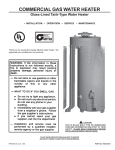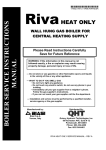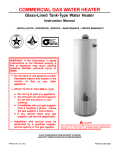Download State Industries Commercial Gas Water Heater User's Manual
Transcript
Instruction Manual for Light Duty Commercial Power Direct Vent Gas Water Heaters ALL TECHNICAL AND WARRANTY QUESTIONS: SHOULD BE DIRECTED TO THE LOCAL DEALER FROM WHOM THE WATER HEATER WAS PURCHASED. IF YOU ARE UNSUCCESSFUL, PLEASE WRITE TO THE COMPANY LISTED ON THE RATING PLATE ON THE WATER HEATER. ODORANT IS ADDED TO THE GAS For Your Safety AN USED BY THIS WATER HEATER WARNING WARNING: If the information in these instructions are not followed exactly, a fire or explosion may result, causing property damage, personal injury or death. –Do not store or use gasoline or other flammable vapors and liquids in the vicinity of this or any other appliance. –WHAT TO DO IF YOU SMELL GAS • Do not try to light any appliance. • Do not touch any electrical switch; do not use any phone in your building. • Immediately call your gas supplier from a neighbor's phone. Follow the gas supplier's instructions. • If you cannot reach your gas supplier, call the fire department. –Installation and service must be performed by a qualified installer, service agency or the gas supplier. Save this Manual for Future Reference. Improper installation, adjustment, alteration, service or maintenance can cause DEATH, SERIOUS BODILY INJURY, OR PROPERTY DAMAGE. Refer to this manual for assistance or consult the local gas utility for further information. WARNING Flammable vapors may be drawn by air currents from other areas of the structure to this appliance. WARNING READ THE GENERAL SAFETY SECTION BEGINNING ON INSIDE COVER AND THEN THIS ENTIRE MANUAL BEFORE INSTALLING OR OPERATING THIS WATER HEATER. 0002917270-1 General Safety WARNING WARNING Improper installation, adjustment, alteration, service or maintenance can cause DEATH, SERIOUS BODILY INJURY, OR PROPERTY DAMAGE. Refer to this manual or consult your local gas utility for further assistance. WATER HEATERS EQUIPPED FOR ONE TYPE GAS ONLY: This water heater is equipped for one type gas only. Check the model rating plate near the gas control valve for the correct gas. DO NOT USE THIS WATER HEATER WITH ANY GAS OTHER THAN THE ONE SHOWN ON THE MODEL RATING PLATE. Failure to use the correct gas can cause problems which can result in DEATH, SERIOUS BODILY INJURY, OR PROPERTY DAMAGE. If you have any questions or doubts consult your gas supplier or local utility. WARNING At the time of manufacture this water heater was provided with a combination temperature-pressure relief valve certified by a nationally recognized testing laboratory that maintains periodic inspection of production of listed equipment or materials, as meeting the requirements for Relief Valves and Automatic Gas Shutoff Devices for Hot Water Supply Systems, and the latest edition of ANSI Z21.22 and the code requirements of ASME. If replaced, the valve must meet the requirements of local codes, but not less than a combination temperature and pressure relief valve certified as meeting the requirements for Relief Valves and Automatic Gas Shutoff Devices for Hot Water Supply Systems, ANSI Z21.22 by a nationally recognized testing laboratory that maintains periodic inspection of production of listed equipment or materials. The valve must be marked with a maximum set pressure not to exceed the marked hydrostatic working pressure of the water heater (150 lbs. p.s.i.) and a discharge capacity not less than the water heater input rate as shown on the model rating plate. (Electric heaters - watts divided by 1000 x 3412 equal BTU/Hr. rate.) Your local jurisdictional authority, while mandating the use of a temperature-pressure relief valve complying with ANSI Z21.22 and ASME, may require a valve model different from the one furnished with the water heater. Compliance with such local requirements must be satisfied by the installer or end user of the water heater with a locally prescribed temperature-pressure relief valve installed in the designated opening in the water heater in place of the factory furnished valve. For safe operation of the water heater, the relief valve must not be removed from it’s designated opening or plugged. The temperature-pressure relief valve must be installed directly into the fitting of the water heater designated for the relief valve. Position the valve downward and provide tubing so that any discharge will exit only within 6 inches above, or at any distance below the structural floor. Be certain that no contact is made with any live electrical part. The discharge opening must not be blocked or reduced in size under any circumstances. Excessive length, over 30 feet, or use of more than four elbows can cause restriction and reduce the discharge capacity of the valve. No valve or other obstruction is to be placed between the relief valve and the tank. Do not connect tubing directly to discharge drain unless a 6″″ air gap is provided. To prevent bodily injury, hazard to life, or property damage, the relief valve must be allowed to discharge water in quantities should circumstances demand. If the discharge pipe is not connected to a drain or other suitable means, the water flow may cause property damage. The Discharge Pipe: —Must not be smaller in size than the outlet pipe size of the valve, or have any reducing couplings or other restrictions. —Must not be plugged or blocked. —Must be of material listed for hot water distribution. —Must be installed so as to allow complete drainage of both the temperature-pressure relief valve, and the discharge pipe. —Must terminate at an adequate drain. —Must not have any valve between the relief valve and tank. WARNING A fire can start if combustible materials such as clothing, cleaning materials, or flammable liquids are placed against or next to the water heater. WARNING INSTALLATIONS IN AREAS WHERE FLAMMABLE LIQUIDS (VAPORS) ARE LIKELY TO BE PRESENT OR STORED (GARAGES, STORAGE, AND UTILITY AREAS, ETC): Flammable liquids (such as gasoline, solvents, propane (LP) or butane, etc.), all of which emit flammable vapors, may be improperly stored or used in such areas. The gas water heater ignitor or main burner can ignite such vapors. The resulting flashback and fire can cause death or serious burns to anyone in the area, as well as property damage. If installation in such areas is your only option, then the installation must be accomplished in a way that the ignitor and main burner flame are elevated from the floor at least 18 inches. While this may reduce the chances of flammable vapors from a floor spill being ignited, gasoline and other flammable substances should never be stored or used in the same room or area containing a gas water heater or other open flame or spark producing appliance. NOTE: Flammable vapors may be drawn by air currents from other areas of the structure to the appliance. WARNING HOTTER WATER CAN SCALD: Water heaters are intended to produce hot water. Water heated to a temperature which will satisfy clothes washing, dish washing, and other sanitizing needs can scald and permanently injure you upon contact. Some people are more likely to be permanently injured by hot water than others. These include the elderly, children, the infirm, or physically/mentally handicapped. If anyone using hot water in your home fits into one of these groups or if there is a local code or state law requiring a certain temperature water at the hot water tap, then you must take special precautions. In addition to using the lowest possible temperature setting that satisfies your hot water needs, some type of tempering device, such as a mixing valve, should be used at the hot water taps used by these people or at the water heater. Mixing valves are available at plumbing supply or hardware stores. Follow manufacturers instructions for installation of the valves. Before changing the factory setting on the thermostat, read the “Temperature Regulation” section in this manual. WARNING BEFORE LIGHTING [PROPANE (L.P.) GAS WATER HEATERS]: Propane (L.P.) gas is heavier than air. Should there be a leak in the system, the gas will settle near the ground. Basements or crawl spaces, closets and areas below ground level will serve as pockets for the accumulation of this gas. Before attempting to operate the water heater or turning on a nearby electrical light switch, be absolutely sure there is no accumulated gas in the area. Search for odor of gas by sniffing at ground level in the vicinity of the appliance. If odor is detected, follow steps indicated at “For Your Safety” on the cover page of this manual then leave the premises. 2 General Safety (cont’d) WARNING WARNING This water heater must not be installed directly on carpeting. Carpeting must be protected by a metal or wood panel beneath the appliance extending beyond the full width and depth of the appliance by at least 3 inches (76.2mm) in any direction, or if the appliance is installed in an alcove or closet, the entire floor must be covered by the panel. Failure to heed this warning may result in a fire hazard. Chemical vapor corrosion of the flue and vent system may occur if air for combustion contains certain chemical vapors. Spray can propellants, cleaning solvents, refrigerator and air conditioner refrigerants, swimming pool chemicals, calcium and sodium chloride, waxes, bleach, and process chemicals are typical compounds which are potentially corrosive. WARNING WARNING Do not install in a confined area such as a closet, unless you provide ventilation air as shown in the “Locating The New Water Heater” section. Never obstruct the flow of ventilation air. If you have any doubts or questions at all, call your gas company. Failure to provide ventilation air can result in a fire or explosion and can cause DEATH, SERIOUS BODILY INJURY, OR PROPERTY DAMAGE. Minimum clearances between the water heater and combustible and non-combustible construction are: 0 inches from sides, 0 inches from back, 6 inches from front of jacket to closet door and 12 inches from top of jacket to combustible and non-combustible material. Minimum vent clearance: 0 inches. Provide 24 inches front clearance for servicing and adequate clearance between the jacket top and ceiling for servicing the flue area. WARNING If this water heater will be used in beauty shops, barber shops, cleaning establishments, or self-service laundries with dry cleaning equipment, it is imperative that the water heater or water heaters be installed so that combustion and ventilation air be taken from outside these areas. Refer to the “Locating The New Water Heater” section of this manual and also the latest edition of the National Fuel Gas Code, ANSI Z223.1, also referred to as NFPA 54 for specifics provided concerning air required. WARNING HYDROGEN GAS: Hydrogen gas can be produced in a hot water system that has not been used for a long period of time (generally two weeks or more). Hydrogen gas is extremely flammable and explosive. To prevent the possibility of injury under these conditions, we recommend the hot water faucet be opened for several minutes at the kitchen sink before any electrical appliances which are connected to the hot water system are used (such as a dishwasher or washing machine). If hydrogen gas is present, there will probably be an unusual sound similar to air escaping through the pipe as the hot water faucet is opened. There must be no smoking or open flame near the faucet at the time it is open. WARNING The power direct vent water heater requires its own (separate) venting system. It cannot be connected to an existing vent pipe or chimney. It must be terminated to the outdoors. Failure to properly install the venting system can result in asphyxiation, a fire or explosion and can cause DEATH, SERIOUS BODILY INJURY, OR PROPERTY DAMAGE. WARNING INSULATING JACKETS: When installing an external water heater insulation jacket on a gas water heater: a. DO NOT cover the temperature-pressure relief valve. b. DO NOT put insulation over any part of the top of the gas water heater. c. DO NOT put insulation over the gas control valve or gas control valve/burner cover, or any access areas to the burner. d. DO NOT let insulation around the gas water heater to get within 8 inches of the floor (air must get to the burner). e. DO NOT cover or remove operating instructions, and safety related warning labels and materials affixed to the water heater. Failure to heed this will result in the possibility of a fire or explosion. WARNING No vent damper installation is compatible with this power vented water heater design. No vent damper, whether it is operated thermally or otherwise is to be installed on this power vented water heater. Alteration of any part of the factory-furnished vent assembly could result in improper operation due to restriction of flue gases, spillage of flue gases and may cause carbon monoxide poisoning. WARNING 1. The appliance and its individual shutoff valve must be disconnected from the gas supply piping system during any pressure testing of the gas system at test pressures in excess of 1⁄2 pound per square inch (3.5kPa). 2. The appliance must be isolated from the gas supply piping system by closing its individual manual shutoff valve during any pressure testing of the gas supply piping system at test pressures equal or less than 1⁄2 pound per square inch (3.5kPa). WARNING Flood damage to a water heater may not be readily visible or immediately detectible. However, over a period of time a flooded water heater will create dangerous conditions which can cause DEATH, SERIOUS BODILY INJURY, OR PROPERTY DAMAGE. Call a qualified service technician or contractor to replace a flooded water heater. Do not attempt to repair the unit! It must be replaced! WARNING Soot build-up indicates a problem that requires correction before further use. Turn “OFF” gas to water heater and leave “OFF” until repairs are made, because failure to correct the cause of the sooting can result in a fire or explosion causing DEATH, SERIOUS BODILY INJURY, OR PROPERTY DAMAGE. CAUTION WATER HEATERS EVENTUALLY LEAK: Installation of the water heater must be accomplished in such a manner that if the tank or any connections should leak, the flow of water will not cause damage to the structure. For this reason, it is not advisable to install the water heater in an attic or upper floor. When such locations cannot be avoided, a suitable drain pan should be installed under the water heater. Drain pans are available at your local hardware store. Such a drain pan must have a minimum length and width of at least 2 inches greater than the water heater dimensions and must be piped to an adequate drain. Drain pan depth must allow for access to the outer doors for servicing the ignitor and burner. Under no circumstances is the manufacturer to be held liable for any water damage in connection with this water heater. WARNING The water heater must be properly vented outdoors. Never operate the water heater unless it is vented to the outdoors and has adequate air supply to avoid risks of improper operation, explosion or asphyxiation. WARNING Vent termination must not be within 4 feet of any items such as gas meters, gas valves or other gas regulating equipment. WARNING Obstructed or deteriorated vent systems may present a serious health risk or asphyxiation. 3 Table of Contents General Safety ...............................................................................................................................2-3 Table of Contents .........................................................................................................................4 Introduction .........................................................................................................................................5 Preparing for the New Installation ..................................................................5 Typical Installation .....................................................................................................................6 Locating the New Water Heater ......................................................................7-9 Facts to Consider About Location .......................................................................................................................7-8 Combustion Air and Ventilation .........................................................................................................................8-9 Venting Clearances ..........................................................................................................................................8-9 Air for Ventilation for Appliances Located in Confined Spaces ..............................................................................9 Installing the New Water Heater ................................................................10-20 Water Piping .......................................................................................................................................................10 Temperature-Pressure Relief Valve ......................................................................................................................11 Filling the Water Heater ......................................................................................................................................12 Wiring............................................................................................................................................................12-13 Optional Field Installed Wiring ....................................................................................................................12-13 Wiring Diagram.................................................................................................................................................13 Venting ..........................................................................................................................................................13-18 Gas Piping......................................................................................................................................................18-19 Installation Checklist ...........................................................................................................................................20 Operating ..........................................................................................................................................21-23 Temperature Regulation ..................................................................................................24 For Your Information ......................................................................................................25-26 Start Up Conditions .............................................................................................................................................25 Condensation ....................................................................................................................................................25 Smoke/Odor ......................................................................................................................................................25 Thermal Expansion ............................................................................................................................................25 Strange Sounds ..................................................................................................................................................25 Operational Conditions ..................................................................................................................................25-26 Smelly Water.....................................................................................................................................................25 "Air” In Hot Water Faucets ................................................................................................................................26 High Temperature Shut Off System....................................................................................................................26 Venting Manual Reset Switch ............................................................................................................................26 Not Enough or No Hot Water ............................................................................................................................26 Water Is Too Hot ...............................................................................................................................................26 Periodic Maintenance ....................................................................................................27-28 Venting System Inspection...................................................................................................................................27 Burner Inspection ................................................................................................................................................27 Burner Cleaning ..................................................................................................................................................27 L.P. Gas Control Valve & Burner Assembly Replacement Information .................................................................27 Housekeeping .....................................................................................................................................................28 Oiling Instructions ...............................................................................................................................................28 Temperature-Pressure Relief Valve Operation......................................................................................................28 Draining ..............................................................................................................................................................28 Service ................................................................................................................................................................28 Leakage Checkpoints............................................................................................................29 Troubleshooting.......................................................................................................................30-33 Installation Diagrams .....................................................................................................34-35 Repair Parts ....................................................................................................................................36-37 4 Introduction Thank You for purchasing this water heater. When installed according to State and Local Codes and maintained according to the manufacturers instructions, it should give you years of trouble free service. WARNING This gas-fired water heater is design certified by CSA INTERNATIONAL under American National Standard/CSA Standard for Gas Water Heaters, ANS Z21.10.3 • CSA 4.3 (latest edition). The installation must conform with this manual, Local Codes and with the latest edition of the National Fuel Gas Code, ANSI Z223.1. This publication is available from your local government or public library, gas company, or by writing NFPA, Batterymarch Park, Quincy, MA 02269. Abbreviations Found In This Instruction Manual CSA - Canadian Standards Association ANSI - American National Standards Institute NFPA - National Fire Protection Association Preparing for the New Installation 1. Read the “General Safety” section, pages 2 and 3 of this manual first and then the entire manual carefully. If you don’t follow the safety rules, the water heater will not operate properly. It could cause DEATH, SERIOUS BODILY INJURY AND/OR PROPERTY DAMAGE. This manual contains instructions for the installation, operation, and maintenance of the gas-fired water heater. It also contains warnings through out the manual that you must read and be aware of. All warnings and all instructions are essential to the proper operation of the water heater and your safety. Since we cannot put everything on the first few pages, READ THE ENTIRE MANUAL BEFORE ATTEMPTING TO INSTALL OR OPERATE THE WATER HEATER. 3. If after reading this manual you have any questions or do not understand any portion of the instructions, call the local gas utility or the manufacturer whose name appears on the rating plate. 4. Carefully plan the place where you are going to put the water heater. Correct combustion, vent action, and intake air and exhaust vent pipe installation are very important in preventing death from possible carbon monoxide poisoning and fires. Examine the location to ensure the water heater complies with the “Locating the New Water Heater” section in this manual. 5. For California installation this water heater must be braced, anchored, or strapped to avoid falling or moving during an earthquake. See instructions for correct installation procedures. Instructions may be obtained from your local dealer, wholesaler, public utilities or California Office of the State Architect, 400 P Street, Sacramento, CA 95814. 2. The installation must conform with the instructions in this manual; gas company rules; and Local Codes, or in the absence of Local Codes, with the latest edition of the National Fuel Gas code, ANSI Z223.1, also referred to as NFPA 54. This publication is available from your local government or public library or gas company or by writing NFPA, Batterymarch Park, Quincy, MA 02269. 6. Massachusetts Code requires this water heater to be installed in accordance with Massachusetts 248-CMR 2.00: State Plumbing Code and 248-CMR 5.00. 7. Complies with SCAQMD rule #1121 and districts having equivalent NOx requirements. 5 Typical Installation EXHAUST VENT TO OUTDOORS INTAKE FOR COMBUSTION AIR Vacuum Relief required by some codes (refer to local codes) AIR INTAKE PIPE COLD WATER INLET FLUE PRODUCTS DISCHARGE PIPE SHUTOFF VALVE HOT WATER OUTLET TEMPERATUREPRESSURE RELIEF VALVE TEMPERED WATER OUTLET MIXING VALVE GAS SUPPLY DISCHARGE PIPE (Do not cap or plug) PROVIDE A 6″″ AIR GAP BETWEEN THE END OF THE DISCHARGE PIPE AND DRAIN 7' POWER CORD (Factory supplied) This appliance has been design certified as complying with American National Standard/CSA Standard for water heaters and is considered suitable for: Water (Potable) Heating: All models are “considered suitable for water (potable) heating.” Water (Potable) Heating and Space Heating: Certain models are “considered suitable for water (potable) heating and space heating.” Refer to the model and rating plate of the water heater. WARNING WARNING If this water heater is to be used for multiple location users, such as for apartments, hotels, motel, duplexes, a tempering device should be used at each point of use (sink, shower, tub, etc.) to limit the maximum temperature of the hot water to 125°F. This will help to reduce, but not eliminate the risk of scald or serious burn injury form exposure to hot water. Water at a temperature above 125°F, can cause 3rd degree burn injuries which are the most serious burns and require skin grafts and results in permanent scarring or even death. Some people are more likely to be permanently injured by hot water than others; these include the elderly, children, the infirm, or the physically/mentally handicapped. Before immersing yourself or anyone else in hot water, be sure to check the water temperature. WARNING: HOTTER WATER INCREASES THE RISK OF SCALD INJURY. (Also see “Temperature Regulation” section) Mixing valves are available at plumbing supply or hardware stores. Follow manufacturer’s instructions for installation of these valves. This water heater shall not be connected to any heating systems or component(s) previously used with a nonpotable water heating appliance. If this water heater is also used for space heating applications, all piping and components connected to the water heater shall be suitable for use with potable water. WARNING Toxic chemicals such as used for treatment of boilers or non-potable water heating appliances shall never be introduced into a potable water space heating system. NOTE: To protect against untimely corrosion of hot and cold water fittings, it is strongly recommended that di-electric unions or couplings be installed on this water heater when connected to copper pipe. 6 Locating the New Water Heater Facts to Consider About the Location 6. The location selection must provide adequate clearances for servicing and proper operation of the water heater. WARNING You should carefully choose an indoor location for the new water heater, because the placement is a very important consideration for the safety of the occupants in the building and for the most economical use of the appliance. This water heater is not for use in manufactured (mobile) homes or outdoor installation. Whether replacing an old water heater or installing the water heater in a new location, the following critical points must be observed. 1. The location selected should be indoors as close as practical to the vent termination point, and as centralized with the water piping system as possible. The water heater, as all water heaters, will eventually leak. Do not install without adequate drainage provisions where water flow will cause damage. 2. If vented through an outside wall or through the roof using 3″ vent piping, the total vent run (vertical and horizontal) cannot exceed a total of 45 feet with one elbow. If more elbows are required, the venting distance must be reduced 5 feet for every 90° elbow. See page 15 for vent chart. 3. Vent piping cannot slope downward and horizontal runs require 1 ⁄8″ per five foot rise. All horizontal runs require adequate support at 31⁄2 foot intervals and vertical runs supported at 5 foot intervals. 4. The water heater requires its own (separate) venting system. It cannot be connected to an existing vent pipe or chimney. It must terminate to the outdoors. Whenever possible terminate the vent on the leeward side of the building through an outside wall. Note: Condensation may be created, at times, as the combustion gases exit the vent cap and discoloration of surfaces in proximity to the vent cap may occur. INSTALLATION IN AREAS WHERE FLAMMABLE LIQUIDS (VAPORS) ARE LIKELY TO BE PRESENT OR STORED (GARAGES, STORAGE AND UTILITY AREAS, ETC): Flammable liquids (such as gasoline, solvents, propane (LP) or butane, etc.) or other substances (such as adhesives, etc.), all of which emit flammable vapors, may be improperly stored or used in such areas. The gas water heater ignitor or main burner can ignite such vapors. The resulting flashback and fire can cause death or serious burns to anyone in the area, as well as property damage. If installation in such areas is your only option, then the installation must be accomplished in a way that the ignitor and main burner flame are elevated from the floor at least 18 inches. While this may reduce the chances of flammable vapors from a floor spill being ignited, gasoline and other flammable substances should never be stored or used in the same room or area containing a gas water heater or other open flame or spark producing appliance. Also, the water heater must be located and/or protected so it is not subject to physical damage by a moving vehicle. NOTE: Flammable vapors may be drawn by air currents from other areas of the structure to the appliance. WARNING Propellants of aerosol sprays and volatile compounds, (cleaners, chlorine based chemicals, refrigerants, etc.) in addition to being highly flammable in many cases, will also change to corrosive hydrochloric acid when exposed to the combustion products of the water heater. The results can be hazardous, and also cause product failure. WARNING The power direct vent water heater requires its own (separate) venting system. It cannot be connected to an existing vent pipe or chimney. It must be terminated to the outdoors. Failure to properly install the venting system can result in asphyxiation, a fire or explosion and can cause DEATH, SERIOUS BODILY INJURY, OR PROPERTY DAMAGE. WARNING This water heater must not be installed directly on carpeting. Carpeting must be protected by a metal or wood panel beneath the appliance extending beyond the full width and depth of the appliance by at least 3 inches (76.2mm) in any direction, or if the appliance is installed in an alcove or closet, the entire floor must be covered by the panel. Failure to heed this warning may result in a fire hazard. 5. The water heater comes equipped with a 7 foot power cord which can be used to connect to a 110/120 volt power source if (1) local codes allow, and (2) there is a three prong receptacle available. WARNING WARNING Do not use an extension cord. If there is not a suitable receptacle with ground and/or local codes prohibit use of a power cord, field wiring must be provided. Minimum clearances between the water heater and combustible and non-combustible construction are: 0 inches from sides, 0 inches from back, 6 inches from front of jacket to closet door and 12 inches from top of jacket to combustible and non-combustible material. Minimum vent clearance: 0 inches. Provide 24 inches front clearance for servicing and adequate clearance between the jacket top and ceiling for servicing the flue area. CAUTION WATER HEATERS EVENTUALLY LEAK: Installation of the water heater must be accomplished in such a manner that if the tank or any connections should leak, the flow of water will not cause damage to the structure. When such locations cannot be avoided, a suitable drain pan should be installed under the water heater. Drain pans are available at your local hardware store. Such a drain pan must have a minimum length and width of at least 2 inches greater than the water heater dimensions and must be piped to an adequate drain. Drain pan depth must allow for access to the outer doors for servicing the ignitor and burner. Under no circumstances is the manufacturer to be held liable for any water damage in connection with this water heater. Figure 1 7 Locating the New Water Heater (cont’d) Facts to Consider About the Location (cont’d) WARNING WARNING Do not install in a confined area such a closet, unless you provide ventilation air as shown in the “Locating The New Water Heater” section. Never obstruct the flow of ventilation air. If you have any doubts or questions at all, call your gas company. Failure to provide ventilation air can result in a fire or explosion and can cause DEATH, SERIOUS BODILY INJURY, OR PROPERTY DAMAGE. Vent termination must not be within 4 feet of any items such as gas meters, gas valves or other gas regulating equipment. WARNING Failure to have required clearances between water heater and combustible material will result in a fire hazard. WARNING If this water heater will be used in beauty shops, barber shops, cleaning establishments, or self-service laundries with dry cleaning equipment, it is imperative that the water heater or water heaters be installed so that combustion and ventilation air be taken from outside these areas. Refer to the “Locating The New Water Heater” section of this manual and also the latest edition of the National Fuel Gas Code, ANSI Z223.1, also referred to as NFPA 54 for specifics provided concerning air required. 9″ min. from any overhang CLof Flue Combustion Air and Exhaust 12″ min. WARNING When determining the installation location for a power direct vent water heater, snow accumulation and drifting should be considered in areas where applicable. Figure 2 Venting Through an Outside Wall – Clearances clearance for 3″ PVC, ABS, or CPVC Schedule 40 piping • 0″ from combustible surfaces. minimum in all directions from any obstruction, such as a • 18″ wall, that may interfere. minimum from the ground and corners, 9″ ceiling over• 12″ hangs. Figure 2. Power Direct Vent outlet terminal shall terminate at least • The 36″ above any forced air inlet located within 10 feet. Figure 3. • The Power Direct Vent outlet terminal shall terminate at least 12″ below 12″ horizontally from or 12″ above any door, window or gravity air inlet into the building. Figure 3. minimum from other natural draft (gravity) direct vent, power • 18″ vent or power direct vent appliance inlet and/or outlet vent(s) when • PD VENT TERMINAL 12″ min. 12″ min. “A” 12″ min. directly above or 135° to either side of center line. Figure 4, page 9. 24″ minimum from any appliance inlet and/or outlet vents when directly below or 45° to either side of center line. Figure 4, page 9. PD VENT TERMINAL ″ 12 n. mi 36″ min. IF “A” DIMENSION IS LESS THAN 120″ 12″ min. location selection must provide clearances for servicing and • The proper operation of the water heater. Figure 5. Figure 3 Vent termination must not be within 4 feet of any items such as • gas meters, gas valves or other gas regulating equipment. E AD GR FORCED AIR INLET CORNER INSTALLATION OF INLET AND OUTLET NOT RECOMMENDED venting system must be installed in a manner which • The allows inspection of the installation of the venting pipes and joints as well as periodic inspection after installation as required by the National Fuel Gas Code ANSI Z223.1. 8 Locating the New Water Heater (cont’d) VENT OUTLET 61⁄2″ MIN. 24″ MAX. Venting Through Roof – Clearances AIR INTAKE for 3″ PVC, ABS, or CPVC Schedule 40 piping • 0″fromclearance combustible surfaces. Vent Exhaust outlet and air inlet terminals shall terminate • The at least 18 inches above the roof surface. Figure 7. venting system must be installed in a manner which • The allows inspection of the installation of the venting pipes 18 ″ ″ 18 24″ 45˚ and joints as well as periodic inspection after installation as required by ANSI Standards. NATURAL DRAFT (GRAVITY) DIRECT VENT, POWER VENT, OR POWER DIRECT VENT APPLIANCE INLET AND/OR OUTLET VENT(S). 45° VENT CAP W/SCREEN 90° STREET ELL Figure 4 Must maintain adequate service and maintenance accessibility. 18″ Range of degrees available for vent pipe installation. Figure 5 WIRE FENCE Figure 7 When the water heater outlet terminal is low enough to be touched accidentally, or is accessible to small children, a wire mesh chain link fence (as shown in Figure 6) may be used. Care should be taken to maintain adequate ventilation around the outlet terminal. If a chain link fence is installed, it must not be used as a storage area for items that may block proper ventilation. Air for Ventilation for Appliances Located in Confined Spaces Air for ventilation should be provided if installed in a confined space. Refer to the National Fuel Gas Code, ANSI Z223.1. NOT TO BE USED AS A STORAGE AREA Figure 6 9 Installing the New Water Heater Water Piping WARNING INTAKE FOR COMBUSTION AIR HOTTER WATER CAN SCALD: Water heaters are intended to produce hot water. Water heated to a temperature which will satisfy clothes washing, dish washing, and other sanitizing needs can scald and permanently injure you upon contact. Some people are more likely to be permanently injured by hot water than others. These include the elderly, children, the infirm, or physically/mentally handicapped. If anyone using hot water in your home fits into one of these groups or if there is a local code or state law requiring a certain temperature water at the hot water tap, then you must take special precautions. In addition to using the lowest possible temperature setting that satisfies your hot water needs, some type of tempering device, such as a mixing valve, should be used at the hot water taps used by these people or at the water heater. Mixing valves are available at plumbing supply or hardware stores. Follow manufacturers instructions for installation of the valves. Before changing the factory setting on the thermostat, read the “Temperature Regulation” section in this manual. EXHAUST VENT TO OUTDOORS AIR INTAKE PIPE SHUTOFF VALVE COLD INLET WATER LINE FLUE PRODUCTS DISCHARGE PIPE This water heater shall not be connected to any heating systems or component(s) used with a non-potable water heating appliance. TEMPERATUREPRESSURE RELIEF VALVE If a water heater is installed in a closed water supply system; such as one having a back-flow preventer, check valve, water meter with a check valve, etc. in the cold water supply; means shall be provided to control thermal expansion. Contact the water supplier or plumbing contractor on how to control this situation. HOT OUTLET TO HOUSE NOTE: To protect against untimely corrosion of hot and cold water fittings, it is strongly recommended that dielectric unions or couplings be installed on this water heater when connected to copper pipe. DISCHARGE PIPE (Do not cap or plug) PROVIDE A 6″″ AIR GAP BETWEEN THE END OF THE DISCHARGE PIPE AND DRAIN The illustration shows the attachment of the water piping to the water heater. The water heater is equipped with 3/4 inch water connections. NOTE: If using copper tubing, solder tubing to an adapter before attaching the adapter to the cold water inlet connection. Do not solder the cold water supply line directly to the cold water inlet or it will harm the dip tube. NOTE: This water heater is insulated to minimize heat loss from the tank. Further reduction in heat loss can be accomplished by insulating the hot water lines from the water heater. 10 GAS SUPPLY Installing the New Water Heater (cont’d) Temperature-Pressure Relief Valve WARNING WARNING The temperature-pressure relief valve must be manually operated at least once a year. Caution should be taken to ensure that (1) no one is in front of or around the outlet of the temperature-pressure relief valve discharge line, and (2) the water manually discharged will not cause any bodily injury or property damage because the water may be extremely hot. If after manually operating the valve, it fails to completely reset and continues to release water, immediately close the cold water inlet to the water heater, follow the draining instructions, and replace the temperature-pressure relief valve with a new one. At the time of manufacture this water heater was provided with a combination temperature-pressure relief valve certified by a nationally recognized testing laboratory that maintains periodic inspection of production of listed equipment or materials, as meeting the requirements for Relief Valves and Automatic Gas Shutoff Devices for Hot Water Supply Systems, and the latest edition of ANSI Z21.22 and the code requirements of ASME. If replaced, the valve must meet the requirements of local codes, but not less than a combination temperature and pressure relief valve certified as meeting the requirements for Relief Valves and Automatic Gas Shutoff Devices for Hot Water Supply Systems, ANSI Z21.22 by a nationally recognized testing laboratory that maintains periodic inspection of production of listed equipment or materials. The valve must be marked with a maximum set pressure not to exceed the marked hydrostatic working pressure of the water heater (150 lbs. p.s.i.) and a discharge capacity not less than the water heater input rate as shown on the model rating plate. (Electric heaters - watts divided by 1000 x 3412) equal BTU/Hr. rate. Your local jurisdictional authority, while mandating the use of a temperature-pressure relief valve complying with ANSI Z21.22 and ASME, may require a valve model different from the one furnished with the water heater. Compliance with such local requirements must be satisfied by the installer or end user of the water heater with a locally prescribed temperature-pressure relief valve installed in the designated opening in the water heater in place of the factory furnished valve. For safe operation of the water heater, the relief valve must not be removed from it’s designated opening or plugged. The temperature-pressure relief valve must be installed directly into the fitting of the water heater designated for the relief valve. Position the valve downward and provide tubing so that any discharge will exit only within 6 inches above, or at any distance below the structural floor. Be certain that no contact is made with any live electrical part. The discharge opening must not be blocked or reduced in size under any circumstances. Excessive length, over 30 feet, or use of more than four elbows can cause restriction and reduce the discharge capacity of the valve. No valve or other obstruction is to be placed between the relief valve and the tank. Do not connect tubing directly to discharge drain unless a 6″″ air gap is provided. To prevent bodily injury, hazard to life, or property damage, the relief valve must be allowed to discharge water in quantities should circumstances demand. If the discharge pipe is not connected to a drain or other suitable means, the water flow may cause property damage. The discharge pipe: —Must not be smaller in size than the outlet pipe size of the valve, or have any reducing couplings or other restriction. —Must not be plugged or blocked. —Must be of material listed for hot water distribution. —Must be installed so as to allow complete drainage of both the temperature-pressure relief valve, and the discharge pipe. —Must terminate at an adequate drain. —Must not have any valve between the relief valve and tank. COLD HOT TEMPERATUREPRESSURE RELIEF VALVE TEMPERED WATER OUTLET DISCHARGE PIPE (Do not cap or plug) PROVIDE A 6″″ AIR GAP BETWEEN THE END OF THE DISCHARGE PIPE AND DRAIN RELIEF VALVE OPENING “THIS WATER HEATER IS PROVIDED WITH A COMBINATION TEMPERATURE-PRESSURE RELIEF VALVE. FOR SAFE OPERATION OF THE WATER HEATER, THE RELIEF VALVE(S) MUST NOT BE REMOVED FROM ITS DESIGNATED POINT OF INSTALLATION OR PLUGGED.” YOUR LOCAL JURISDICTIONAL AUTHORITY, WHILE MANDATING THE USE OF A TEMPERATURE-PRESSURE RELIEF VALVE COMPLYING WITH ANSI Z21.22 AND ASME, MAY REQUIRE A VALVE MODEL DIFFERENT FROM THE ONE FURNISHED WITH THE WATER HEATER. COMPLIANCE WITH SUCH LOCAL REQUIREMENTS MUST BE SATISFIED BY THE INSTALLER OR END USER OF THE WATER HEATER WITH A LOCALLY PRESCRIBED TEMPERATURE-PRESSURE RELIEF VALVE INSTALLED IN THE DESIGNATED OPENING IN THE WATER HEATER. SEE MANUAL HEADING—“TEMPERATURE-PRESSURE RELIEF VALVES” FOR INSTALLATION AND MAINTENANCE OF RELIEF VALVE, DISCHARGE LINE AND OTHER SAFETY PRECAUTIONS. 11 Installing the New Water Heater (cont’d) Filling the Water Heater You must provide all wiring of the proper size outside of the water heater. You must obey local codes and electric company requirements when you install this wiring. CAUTION If you are not familiar with electric codes and practices, or if you have any doubt in your ability to connect the wiring to this water heater, obtain the service of a competent electrician. Contact a local electrical contractor and/or the local electric utility. Never use this water heater unless it is completely filled with water. To prevent damage to the tank, the tank must be filled with water. Water must flow from the hot water faucet before turning “ON” gas to the water heater. WARNING To fill the water heater with water: 1. Close the water heater drain valve by turning the handle to the right (clockwise). The drain valve is on the lower front of the water heater. 2. Open the cold water supply valve to the water heater. NOTE: The cold water supply valve must be left open when the water heater is in use. 3. To insure complete filling of the tank, allow air to exit by opening the nearest hot water faucet. Allow water to run until a constant flow is obtained. This will let air out of the water heater and the piping. 4. Check all new water piping for leaks. Repair as needed. WATER HEATERS EQUIPPED FOR ONE TYPE VOLTAGE ONLY: This water heater is equipped for 110/120 volts only. DO NOT USE THIS WATER HEATER WITH ANY VOLTAGE OTHER THAN THE ONE SHOWN ABOVE. Failure to use the correct voltage can cause problems which can result in DEATH, SERIOUS BODILY INJURY OR PROPERTY DAMAGE. If you have nay questions or doubts consult your electric company. CAUTION If wiring from the fuse box or circuit breaker box was aluminum for the old water heater, replace it with copper wire. If you wish to reuse the existing aluminum wire, have the connection at the water heater made by a competent electrician. Contact a local electrical contractor and/or the local electric utility. Wiring The water heater comes equipped with a 7 foot power cord which can be used to connect to a 110/120 volt power source if, (1) local codes allow, and (2) there is a three prong receptacle available. This unit must have a grounded outlet to operate. OPTIONAL Field Installed Wiring 1. Provide a way to easily shut off the electric power when working on the water heater. This could be with a circuit breaker or fuse block in the entrance box or a separate disconnect switch. You must provide all wiring, (1) to a receptacle or, (2) between the water heater and junction box when the power cord is not used. 2. Install and connect a circuit directly from the main fuse or circuit breaker box. This circuit must be the right size and have its own fuse or circuit breaker. WARNING This appliance must be grounded for safety and to insure proper operation. Failure to do so could result in DEATH, SERIOUS BODILY INJURY OR PROPERTY DAMAGE. WIRE NUTS 7’ MAXIMUM CORD LENGTH (Factory Supplied) CONDUIT GREEN GROUND SCREW WARNING 3. A standard 1⁄2″ conduit opening has been made in the water heater junction box for the conduit connection. 4. Use wire nuts and connect the power supply wiring to the wires inside the water heater’s junction box. Do not use an extension cord. If there is not a suitable receptacle and/or local codes prohibit use of a power cord, field wiring must be provided. 12 Installing the New Water Heater (cont’d) 5. The water heater must be electrically “grounded” by the installer. The unit will not operate unless it is properly grounded. For complete grounding details and all allowable exceptions, refer to local codes or in the absence of local codes, with the National Electrical Code, ANSI/NFPA 70 (latest edition). 6. Replace the wiring junction cover using the screws provided. HI LIMIT WHITE BLUE YELLOW NEUTRAL ON/OFF SWITCH BLACK BLOWER HOT Wiring Diagram HI LIMIT SWITCH NO PS NC PRESSURE SWITCH C ON/OFF WHC NEUTRAL WHITE IGNITOR 5 CONTROL 6 WHITE N I2 L1 l1 YELLOW BLOWER BLUE 1 3 5 6 7 7 CAUTION BLACK MAIN VALVE BLUE L1 RED GROUND GREEN BROWN N RED BLACK HOT IGNITOR SENSOR Label all wires prior to disconnection when servicing controls. Wiring errors can cause improper and dangerous operation. Verify proper operation after servicing. Venting WARNING The vent pipe from the water heater must be 3″″ diameter vent pipe and must slope upward 1⁄8 inch per five linear feet. WARNING To insure proper venting of this gas-fired water heater, the correct vent pipe diameter must be utilized. Any additions of other gas appliances on vent with this water heater will adversely affect the operation of the water heater. All vent gases must be completely vented to the outdoors of the structure (dwelling). MIN. RISE 1⁄8″ PER FIVE FEET WARNING The vent outlet must connect to the water heater exhaust outlet. The vent inlet piping must connect to the water heater air inlet. Both the water heater connections are clearly marked. Failure to read this instruction can result in DEATH, SERIOUS BODILY INJURY, OR PROPERTY DAMAGE. WARNING WARNING Obstructed or deteriorated vent systems may present serious health risk or asphyxiation. Failure to have required clearances between water heater and combustible material will result in a fire hazard. 13 Installing the New Water Heater (cont’d) Venting (cont’d) 3″ ABS SCHEDULE 40 90° STREET OUTLET ELBOW SUPPLIED WARNING Be sure vent pipe is properly connected to prevent escape of dangerous flue gases which could cause deadly asphyxiation. 3″ PVC SCHEDULE 40 90° STREET INLET ELBOW REQUIRED WARNING Chemical vapor corrosion of the flue and vent system may occur if air for combustion contains certain chemical vapors. Spray can propellants, cleaning solvents, refrigerator and air conditioner refrigerants, swimming pool chemicals, calcium and sodium chloride, waxes, bleach and process chemicals are typical compounds which are potentially corrosive. 5' SCHEDULE 40 ABS OUTLET PIPE SUPPLIED ONE 3″ SCHEDULE 40 PVC 45° INLET ELBOW SUPPLIED SCHEDULE 40 PVC INLET PIPE REQUIRED ONE 3″ SCHEDULE 40 PVC 45° OUTLET ELBOW SUPPLIED 1. The water heater requires its own (separate) venting system. 2. Only 3″ ABS Schedule 40 piping and fittings are acceptable materials on the first five feet of the outlet vent system. 3. 3″ PCV, ABS, or CPVC Schedule 40 piping and fittings are acceptable materials for the inlet vent system and for the outlet vent system after the first five feet. 4. It cannot be connected to existing vent piping or chimney. 5. When venting through an outside wall, the vents must terminate horizontally to the outdoors. 31⁄2' STRAPPING Horizontal runs must be securely supported at 31⁄2 foot intervals and vertical runs supported at 5 foot intervals. VENTING THROUGH AN OUTSIDE WALL In the carton is supplied: 1. Two 3″ inlet and outlet PVC Schedule 40 - 45° vent caps. 2. A 3″ ABS Schedule 40 - 90 street ell; used to connect the outlet vent pipe to the water heater when the outlet vent pipe is to be turned horizontally directly off the blower. 3. A 5‘ section of 3″ ABS Schedule 40 outlet vent pipe (more may be required and must be supplied locally). 14 Installing the New Water Heater (cont'd) VENTING SYSTEM EXAMPLE INSTALLATIONS FOR ALL MODELS 3 ELBOW EXAMPLE MIN. RISE 1⁄8″ PER FIVE FEET The vent piping cannot under any circumstances be run downhill. CAULK JOINT MIN. RISE 1⁄8″ PER FIVE FEET 2. The total vertical and horizontal vent runs cannot exceed the maximum length with the number of 90˚ elbows as specified in the table below. If more elbows are required, the venting distance must be reduced 5 feet for every 90° elbow: The vent piping can be installed as follows: 1. Horizontal runs require a minimum 1/8″ rise per five feet. 3″ DIA. VENTS MAX. LENGTH (FT.) 45 40 35 3 ELBOW EXAMPLE NUMBER OF 90˚ DEG. ELBOWS* 1 2 3 *NOTE: Two 45˚ elbows are equivalent to one 90° elbow. One 90˚ elbow equals 5 feet of equivalent vent length. MIN. RISE 1⁄8″ PER FIVE FEET 1 ELBOW EXAMPLE 45′ MAX. 18″ MIN. 111⁄4″ MIN. 131⁄4″ MIN. 1 ELBOW EXAMPLE MIN. RISE 1⁄8″ PER FIVE FEET 38′ MIN. RISE 1⁄8″ PER FIVE FEET 3 ELBOW EXAMPLE 7″ MIN. RISE 1⁄8″ PER FIVE FEET ONE ELBOW 3. Minimum vent length for all models is 18 inches. 15 Installing the New Water Heater (cont'd) Cementing PVC, ABS OR CPVC Pipe and Fittings VENT PIPE SEPARATION Read and observe all safety information printed on primer, cleaner, and cement containers. The inlet and outlet vent pipes must be separated by a minimum distance of 61/2″ inches up to 24 inches maximum. 61/2″ MIN. 24″ MAX. DANGER Primer, cleaner, and cements are extremely flammable. They are harmful or fatal if swallowed. The vapors are harmful. They may irritate eyes and skin and can be absorbed through the skin. PRECAUTIONS NOTE: Inlet and outlet vent pipes from multiple power direct vent water heaters must be separated from adjacent heater vent pipes by a minimum of 61/2″. Always store primers, cleaner, and cements in cool, dry, well ventilated places. Do not store them near heat, sparks, or flames. Keep containers closed. Use them in well ventilated areas. Wear impervious clothing while handling. Do not smoke, eat, or drink while handling. Wash thoroughly after handling and before eating. Wear eye protection when handling. If swallowed, drink water, do not induce vomiting, and call a physician or poison control center immediately. If inhaled, get fresh air and seek medical attention if ill feelings persist. In case of eye and skin contact, immediately flush with plenty of water for 15 minutes and seek medical attention if irritation persists. KEEP OUT OF REACH OF CHILDREN. CUTTING OPENINGS THROUGH AN OUTSIDE WALL AND COLLAR INSTALLATION After reading the manual and you have determined the location of the opening in the wall, (using the drawing below), cut one 31⁄2″ diameter hole for the inlet vent piping and one 31⁄2″ diameter hole for the outlet vent piping through an exterior wall. NOTE: When determining location of the openings in the outside wall allow for the 1⁄8″ rise per five feet that has taken place in the horizontal run. All primers, cleaners, and cements must meet all local codes and applicable standards of the American Society For Testing Materials Standards. CL OF FLUE Before using primers, cleaners, and cements, stir or shake, making sure contents are liquid. Do not use if found to be lumpy or jelly-like. 1. Cut pipe ends squarely removing all burrs and dirt. 2. Dry fit pipe and fittings to be connected for proper fit. 3. Clean pipe and fitting with a primer/cleaner. 4. Apply a thin coat of cement to fitting, avoiding puddling inside. 5. Apply a liberal coat of cement to pipe leaving no voids. 6. QUICKLY assemble parts while cement is fluid! If you wait too long, re-coat pipes. 7. Push pipe completely into socket of fitting, turning as it goes until it bottoms. 8. Hold pipe and fitting together for 30 seconds. Then carefully clean off excess with a cloth. Allow connections a sufficient time to cure before disturbing. 9. Remember that vent pipes must be adequately and securely supported. 111⁄ ″ MIN. 2 75 GAL.– 63″ The 3″ PVC, ABS or CPVC Schedule 40 vent pipe can be run from the water heater through the wall or from the wall to the water heater, whichever is most convenient. The vent pipe must extend a minimum of 11⁄2″ through the exterior wall. Extending the vent cap as far as possible from the surface of the exterior wall will help minimize discoloration of the wall. Note that the inside flue mounting adaptors must be slipped over the vent piping before locating the pipe through the wall. Before securing the inside and outside collars to the wall, use a silicone sealer between pipe and opening to insure a water and air tight seal. APPROXIMATE SETTING TIME FOR 21⁄2″ TO 4″ PIPE JOINTS 90°F to 150°F 50°F to 90°F 0°F to 50°F MOVEMENT OF JOINT 3 ⁄4 hr. 1 hr. 11⁄3 hr. MIN. RISE 1⁄8″ PER FIVE FEET COMPLETE SET 8 hrs. 15 hrs. 18 hrs. 16 Installing the New Water Heater (cont'd) Venting (cont'd) INSTALLATION SHOWING USE OF (OPTIONAL) DELUXE HORIZONTAL VENT KIT: INSTALLATION SHOWING USE OF PVC, ABS OR CPVC PIPE FOR INLET AND OUTLET VENT PIPING: Typical installation. Inlet piping through any type wall. VENT TO OUTDOORS EXTERIOR WALL SILICONE SEALER INTAKE FOR COMBUSTION AIR FLUE PRODUCTS DISCHARGE PIPE 11⁄2" MIN. EXTENSION THROUGH EXTERIOR WALL SCREW SCREW SCREW FLUE MOUNTING ADAPTOR SILICONE SEALER SCREW FLUE MOUNTING ADAPTOR AIR INTAKE PIPE VENT CAP MUST BE POSITIONED DOWNWARD SCREEN AT OUTLET CONNECTING VENT TO BLOWER 1. If making an immediate horizontal run of vent off the blower, one 3″ PVC inlet and one 3″ ABS outlet Schedule 40 street elbows are required. Place the elbow in the required direction on the blower and using 3 sheet metal screws, attach the elbow. CAULK JOINTS If this concentric flue, through the wall type of venting system is preferred, the vent kit can be ordered from the Service Parts Dept. under kit #9002749. See also pages 36 and 37. Installation instructions are provided with the kit. 2. If there is to be a vertical run of vent from the blower, the 3″ PVC inlet and the 3″ ABS outlet pipes must be attached to the blower and venting hood, using 6 sheet metal screws. VENTING THROUGH A ROOF CAULK JOINTS Two 3″ inlet and outlet PVC Schedule 40 45° vent caps are supplied. A 5’ section of 3″ ABS Schedule 40 outlet vent pipe is supplied. More may be required and must be supplied locally. 1. The water heater requires its own (separate) venting system. 17 Installing the New Water Heater (cont’d) Gas Piping VENTING THROUGH A ROOF (CONT’D) 2. Only 3″ ABS Schedule 40 piping and fittings are acceptable materials on the first five feet of the outlet vent system. WARNING 3. 3″ PVC, ABS, or CPVC Schedule 40 piping and fittings are acceptable materials for the inlet vent system and for the outlet vent system after the first five feet. Make sure the gas supplied is the same type listed on the model rating plate. The inlet gas pressure must not exceed 10.5 in. water column (2.6kPa)for natural gas or 13 in. water column (3.2 kPa) for propane (L.P.) gas. The minimum inlet gas pressure listed on the rating plate is for the purpose of input adjustment. 4. It cannot be connected to existing vent piping or chimney. 5. It must terminate vertically to the outdoors. 6. The total vertical and horizontal vent runs cannot exceed the maximum length with a maximum number of 90˚ elbows as specified in the table below. If more elbows are required, the venting distance must be reduced 5 feet for every 90° elbow. 3″ DIA. VENTS MAX. LENGTH (FT.) 45 40 35 WARNING If the gas control valve is subjected to pressure exceeding 1/2 pound per square inch (3.5kPa), the damage to the gas control valve could result in a fire or explosion from leaking gas. NUMBER OF 90˚ DEG. ELBOWS* 1 2 3 WARNING If the main gas line shutoff serving all gas appliances is used, also turn “OFF” the gas at each appliance. Leave all gas appliances turned “OFF” until the water heater installation is complete. *NOTE: Two 45˚ elbows are equivalent to one 90˚ elbow. One 90˚ elbow equals 5 feet of equivalent vent length. A gas line of sufficient size must be run to the water heater. Consult the latest edition of National Fuel Gas Code ANSI Z223.1, also referred to as NFPA 54 and the gas company concerning pipe size. There must be: —A readily accessible manual shut off valve in the gas supply line serving the water heater, and —A drip leg (sediment trap) ahead of the gas control valve to help prevent dirt and foreign materials from entering the gas control valve. —A flexible gas connector or a ground joint union between the shutoff valve and control valve to permit servicing of the unit. Be sure to check all the gas piping for leaks before lighting the water heater. Use a soapy water solution, not a match or open flame. Rinse off soapy solution and wipe dry. When installed at elevations above 2,000 feet, input ratings should be reduced at the rate of 4 percent for each 1,000 feet above sea level. WARNING The appliance and its individual shutoff valve must be disconnected from the gas supply piping system during any pressure testing of that system at test pressures in excess of 1/2 pound per square inch (3.5kPa). The appliance must be isolated from the gas supply piping system by closing its individual manual shutoff valve during any pressure testing of the gas supply piping system at test pressures equal to or less than 1/2 pound per square inch (3.5kPa). TOTAL VERTICAL AND HORIZONTAL RUNS - SEE CHART ABOVE (ITEM 6). 18 Installing the New Water Heater (cont’d) GAS PIPING WITH FLEXIBLE CONNECTOR WARNING The appliance and its gas connection must be leak tested before placing the appliance in operation. GAS SUPPLY PIPING WARNING Use pipe joint compound or teflon tape marked as being resistant to the action of petroleum [Propane (L.P.)] gases. MANUAL SHUTOFF VALVE FLEXIBLE GAS CONNECTOR LABELED AS COMPLYING WITH ANSI STANDARDS Connecting the gas piping to the gas control valve of the water heater can be accomplished by either of the two methods shown. GROUND JOINT UNION (OPTIONAL) SEDIMENT TRAP A sediment trap shall be installed as close to the inlet of the water heater as practical at the time or water heater installation. The sediment trap shall be either a tee fitting with a capped nipple in the bottom outlet or other device recognized as an effective sediment trap. If a tee fitting is used, it shall be installed in conformance with one of the methods of installation shown. 3″ MIN. LOOP DRIP LEG (SEDIMENT TRAP) GAS CONTROL VALVE CAP GAS PIPING WITH ALL BLACK IRON PIPE TO GAS CONTROL WARNING Contaminants in the gas lines may cause improper operation of the gas control valve that may result in fire or explosion. Before attaching the gas line be sure that all gas pipe is clean on the inside. To trap any dirt or foreign material in the gas supply line, a drip leg (sometimes called a sediment trap) must be incorporated in the piping. The drip leg must be readily accessible. Install in accordance with the “Gas Piping” section. Refer to the latest edition of the National Fuel Gas Code, ANSI Z223.1, also referred to as NFPA 54. GAS SUPPLY PIPING MANUAL SHUTOFF VALVE GROUND JOINT UNION (OPTIONAL) BLACK PIPE 3″ MIN. DRIP LEG (SEDIMENT TRAP) CAP 19 GAS CONTROL VALVE Installing the New Water Heater (cont’d) Installation Checklist BEFORE OPERATING THE WATER HEATER: 1. Check the gas line for leaks. a. Use a soapy water solution. DO NOT test for gas leaks using a match or open flame. b. Brush the soapy water solution on all gas pipes, joints and fittings. c. Check for bubbling soap. This means you have a leak. Turn “OFF” gas and make the necessary repairs. d. Recheck for leaks. e. Rinse off soapy solution and wipe dry. 2. Is the new temperature-pressure relief valve properly installed and piped to an adequate drain? See “TemperaturePressure Relief Valve” section. 3. Are the cold and hot water lines connected to the water heater correctly? See “Water Piping” instructions in the “Installing the New Water Heater” section. EXHAUST VENT TO OUTDOORS INTAKE FOR COMBUSTION AIR Vacuum Relief required by some codes (refer to local codes) 4. Is the water heater completely filled with water? See “Filling the Water Heater” instructions in the “Installing the New Water Heater” section. 5. Will a water leak damage anything? See the “Locating the New Water Heater” section. 6. Is there proper clearance between the water heater and anything that might catch fire? See the “Locating the New Water Heater” section. 7. Do you have adequate ventilation so that the water heater will operate properly? See “Air for Ventilation” in the “Locating the New Water Heater” section. 8. Is the vent piping properly secured? See “Venting” instructions in the “Installing the New Water Heater” section. 9. Is there proper clearance between the vent pipe and anything that might catch fire? See “Venting” instructions in the “Installing the New Water Heater” section. 10. Is the vent pipe properly sloped and does the vent terminate outdoors? See “Venting” instructions in the “Installing the New Water Heater” section. 11. Do you need to call your gas company to check the gas pipe and its hookup? AIR INTAKE PIPE COLD WATER INLET FLUE PRODUCTS DISCHARGE PIPE SHUTOFF VALVE HOT WATER OUTLET TEMPERATUREPRESSURE RELIEF VALVE TEMPERED WATER OUTLET DISCHARGE PIPE (Do not cap or plug) PROVIDE A 6″″ AIR GAP BETWEEN THE END OF THE DISCHARGE PIPE AND DRAIN SUITABLE FOR WATER (POTABLE) HEATING AND SPACE HEATING GAS SUPPLY SHUTOFF VALVE DIRECT VENT AUTOMATIC STORAGE WATER HEATER DIRECT VENT AUTOMATIC CIRCULATING TANK WATER HEATER ELECTRICAL RATING: VOLTS 115/HZ60/AMPS 2 TEE DRIP LEG (Sediment trap) MODEL RATING PLATE PIPE CAP 20 Operating This water heater is equipped with an electrically operated venting system and electronic control. For the burner to come on, the water heater thermostat must call for heat. Then the system will begin sequencing, each section proving itself before gas is allowed to flow to the burner. BLOWER MOTOR VENTING MANUAL RESET SWITCH BEFORE THE WATER HEATER WILL OPERATE: 1. The control system must be connected to a grounded 110/120 volt power supply. The control system has an overall rating of 2 amps. The water heater must be securely and adequately grounded in accordance with local codes and with the latest edition of the National Electrical Code ANSI/NFPA 70. VENTING HOOD ON/OFF SWITCH 2. The ON/OFF toggle switch, located on the control box above the thermostat must be in the “ON” position for the electrical control system to operate allowing the gas portion to operate (ignite burner). AIR PRESSURE SWITCH 3. The gas control knob located on the thermostat must be turned to the “ON” position for the gas to be able to flow. 4. The venting manual reset switch must be in the closed position. See “Venting Manual Reset Switch” in the “For Your Information” section. 5. There is a non-resettable hi-limit switch in the thermostat, which must be good (closed) for the thermostat to be operated. See “High Temperature Shut Off System” in the “For Your Information” section. GAS CONTROL KNOB OPERATION When the thermostat calls for heat, gas is allowed to flow to a (N/O) pressure switch closing it. An electrical circuit is then made to the blower, turning it on. When the blower has achieved sufficient venting, the air pressure switch will close. A 120 volt circuit will be completed through the venting manual reset switch and on to the 120 volt gas valve. The 120 volt gas valve will open allowing gas to flow to the burner. The hot surface ignitor will establish a main burner flame. 120V GAS VALVE DIAGNOSTIC INDICATOR BURNER GAS THERMOSTAT HOT SURFACE IGNITOR 21 Operating (cont’d) WARNING BEFORE LIGHTING [PROPANE (L.P.) GAS WATER HEATERS]: Propane (L.P.) gas is heavier than air. Should there be a leak in the system, the gas will settle near the ground. Basements or crawl spaces, closets and areas below ground level will serve as pockets for the accumulation of this gas. Before attempting to operate the heater or turning a nearby electrical light switch, be absolutely sure there is no accumulated gas in the area. Search for odor of gas by sniffing at ground level in the vicinity of the appliance. If odor is detected, follow the steps indicated at “For Your Safety” on the cover page of this manual, then leave the premises. Figure 8 Operating instructions are located on front of the water heater, above or to one side of the gas control valve. WARNING AN ODORANT IS ADDED TO THE GAS USED BY THIS WATER HEATER. FOR YOUR SAFETY IF YOU SMELL GAS: 1. Do not try to light any appliance. 2. Do not touch any electrical switch; do not use an phone in your building. 3. Immediately call you gas supplier from a neighbor’s phone. Follow the gas supplier’s instructions. 4. If you cannot reach your gas supplier, call the fire department. Figure 9 WARNING DO NOT force the gas control knob. Use only your hand to turn it to “ON” or “OFF”. Never use a tool such as a lever, wrench or pliers. Do not hit or damage the knob. A damaged knob may result in an explosion and serious injury. If you have problem turning the knob, call the gas supplier immediately. INNER DOOR CHECK FOR LEAKS Be sure to check all your gas pipes for leaks before lighting your water heater. Use a soapy water solution, not a match or open flame. Check the factory gas fittings when the main burner is turned “ON”. Use a soapy water solution for this, too. OUTER DOOR Figure 10 22 Operating (cont’d) FOR YOUR SAFETY READ BEFORE OPERATING WARNING If you do not follow these instructions exactly, a fire or explosion may result causing property damage, personal injury or loss of life. • If you cannot reach your gas supplier, call the fire A. This appliance does not have a pilot. It is equipped with an ignition device which automatically lights the burner. Do not try to light the burner by hand. B. BEFORE OPERATING smell all around the appliance area for gas. Be sure to smell next to the floor because some gas is heavier than air and will settle on the floor. WHAT TO DO IF YOU SMELL GAS • Do not try to light any appliance. • Do not touch any electric switch; do not use any phone in your building. • Immediately call your gas supplier from a neighbor’s phone. Follow the gas supplier’s instructions. department. C. Use only your hand to push in or turn the gas control knob. Never use tools. If the knob will not push in or turn by hand, don’t try to repair it, call a qualified service technician. Force or attempted repair may result in a fire or explosion. D. Do not use this appliance if any part has been under water. Immediately call a qualified service technician to inspect the appliance and to replace any part of the control system and any gas control which has been under water. OPERATING INSTRUCTIONS 1. STOP! Read the safety information above on this label. 2. Set ON/OFF switch lever on control box to “OFF”. 3. Set the thermostat to lowest setting by turning the water temperature dial counter-clockwise, ( ) to its lowest temperature setting. DO NOT FORCE. Turn gas control knob clockwise to “OFF” position. (Figure 6) 4. Wait five (5) minutes to clear out any gas. If you then smell gas, STOP! Follow “B” in the safety information above on this label. If you don’t smell gas, go to the next step. 5. Replace (or close) inner door. Replace outer doors. WARNING: Check outer doors. Outer doors must be installed before turning gas control knob to “ON” position. 6. At arms length away, turn gas control knob counterclockwise to the full “ON” position. (Figure 7) TOP VIEW OF GAS CONTROL WARNING Do not use gas control knob to regulate gas flow. 7. At arms length away, set the thermostat to desired setting. The mark (▲) HOT indicative of approximate 120°F is preferred starting point. Some local laws may require a lower starting point. If hotter water is desired, see instruction manual and “warning” below. 8. Set ON/OFF switch lever on control box to “ON”. WARNING Hotter water increases the risk of scald injury. Before changing temperature setting see instruction manual. For operation at outlet water temperature not in excess of 180°F. TO TURN OFF GAS TO APPLIANCE 1. Set ON/OFF switch lever on control box to “OFF”. 2. Set the thermostat to lowest setting by turning the water temperature dial counter-clockwise ( ) to its lowest temperature setting. DO NOT FORCE. 3. Turn gas control knob clockwise ( position. ) to “OFF” WARNING This water heater is equipped for one type gas only. Check the rating plate near the gas control valve for the correct gas. Do not use this water heater with any gas other than the one listed on the rating plate. Failure to use the correct gas can cause problems which can result in death, serious bodily injury or property damage. If you have any questions or doubts consult your gas supplier or gas utility. Insulation blanket or other insulation wrapping, applied external to the jacket, may result in unsafe operation of the water heater. For additional information, see instruction manual. 23 Temperature Regulation Due to the nature of the typical gas water heater, the water temperature in certain situations may vary up to 30°F higher or lower at the point of use such as, bathtubs, showers, sink, etc. Turn the water temperature dial clockwise ( increase the temperature, or counterclockwise ( decrease the temperature. ) to ) to This means that when the temperature adjustment dial is set at the mark approximating 120°F, the actual water temperature at any hot water tap could be as high as 150°F or as low as 90°F. Any water heater’s intended purpose is to heat water. Hot water is needed for cleaning, (bodies, dishes, clothing). Hot water will present a scald hazard. Depending on the time element, and the people involved (normal adults, children, toddlers, elderly, infirm, etc.) scalding may occur at different temperatures. ▲ ▲ ▲ ▲ ▲ ▲ ▲ ▲ ▲ ▲ ▲ ▲ ▲ ▲ WARNING ▲ HOTTER WATER CAN SCALD: Water heaters are intended to produce hot water. Water heated to a temperature which will satisfy clothes washing, dish washing, and other sanitizing needs can scald and permanently injure you upon contact. Some people are more likely to be permanently injured by hot water than others. These include the elderly, children, the infirm, or physically/mentally handicapped. If anyone using hot water in your home fits into one of these groups or if there is a local code or state law requiring a certain temperature water at the hot water tap, then you must take special precautions. In addition to using the lowest possible temperature setting that satisfies your hot water needs, some type of tempering device, such as a mixing valve, should be used at the hot water taps used by these people or at the water heater. Mixing valves are available at plumbing supply or hardware stores. A qualified plumber should be consulted. Follow manufacturers instructions for installation of the valves. Before changing the factory setting on the thermostat, read the “Temperature Regulation” section in this manual. ▲HOT– Is a thermostat setting of approximate 120°F which will supply hot water at the most economical temperatures. The temperature adjustment knob can be turned lower than “HOT” if desired. A– Is a thermostat setting of approximately 140°F. B– Is a thermostat setting of approximately 150°F. C– Is a thermostat setting of approximately 160°F. D–Is a thermostat setting of approximately 170°F. VERY HOT– Is a thermostat setting of approximately 180°F. It is recommended that the dial be set lower whenever possible. NOTE: Water temperature range of 120°–140°F recommended by most dishwasher manufacturers. WARNING WARNING Never allow small children to use a hot water tap, or to draw their own bath water. Never leave a child or handicapped person unattended in a bathtub or shower. Should overheating occur or the gas supply fail to shut off, turn “OFF” the manual gas control valve to the appliance. The thermostat of this water heater has been factory set at its lowest position, to reduce the risk of scald injury. It is adjustable and must be reset to the desired temperature setting. The mark (▲) HOT which is indicative of approximately 120°F is the preferred starting point. Some states have a requirement for a lower setting. If you need hotter water, follow directions for temperature adjustment, but beware of the warnings in this section. 24 For Your Information Start Up Conditions CONDENSATION It is recommended that any devices installed which could create a closed system have a by-pass and/or the system have an expansion tank to relieve the pressure built by thermal expansion in the water system. Expansion tanks are available for ordering through local plumbing supply houses. Contact the local water supplier and/or plumbing contractor for assistance in controlling these situations. Whenever the water heater is filled with cold water, a certain amount of condensation will form while the burner is on. A water heater may appear to be leaking when in fact the water is condensing. This usually happens when: a. When a new water heater is filled with cold water for the first time. b. When gas burns and water vapor is produced in water heaters, particularly high efficiency models where flue temperatures are lower. c. When you use large amounts of hot water in a short time and the refill water is very cold. STRANGE SOUNDS Possible noises due to expansion and contraction of some metal parts during periods of heat-up and cool-down do not represent harmful or dangerous conditions. Condensation causes sizzling and popping with the burner area during heating and cooling periods and should be considered normal. See “Condensation” in this section. Moisture from the products of combustion condenses on the cooler tank surfaces and form drops of water which may fall onto the burner or other hot surfaces and produce a “sizzling” or “frying” noise. Because of the suddenness and amount of water, condensation water may be diagnosed as a “tank leak”. After the water in the tank warms up (about 1-2 hours), the condition should disappear. Operational Conditions Do not assume the water heater is leaking until there has been enough time for the water in the tank to warm up. In each water heater there is installed at least one anode rod (see parts section) for corrosion protection of the tank. Certain water conditions will cause a reaction between this rod and the water. The most common complaint associated with the anode rod is one of a “rotten egg smell”. This odor is derived from hydrogen sulfide gas dissolved in the water. The smell is the result of four factors which must all be present for the odor to develop: a. a concentration of sulfate in the supply water. b. little or no dissolved oxygen in the water. c. a sulfate reducing bacteria within the water heater. (This harmless bacteria is non-toxic to humans.) d. an excess of active hydrogen in the tank. This is caused by the corrosion protective action of the anode. SMELLY WATER An undersized water heater will cause more condensation. The water heater must be sized properly to meet the family’s demands for hot water including dishwashers, washing machines and shower heads. Excessive condensation may be noticed during the winter and early spring months when incoming water temperatures are at their lowest. Good venting is essential for a gas fired water heater to operate properly as well as to carry away products of combustion and water vapor. Smelly water may be eliminated or reduced in some water heater models by replacing the anode(s) with one of less active material, and then chlorinating the water heater tank and all hot water lines. Contact the local water heater supplier for further information concerning an Anode Replacement Kit #9000029 and this Chlorination Treatment. SMOKE/ODOR It is not uncommon to experience a small amount of smoke and odor during the initial start-up. This is due to burning off of oil from metal parts, and will disappear in a short while. THERMAL EXPANSION If the smelly water persists after the anode replacement and chlorination treatment, we can only suggest that continuous chlorination and filtering conditioning equipment be considered to eliminate the water problem. Because of such events as high line pressure, frequent cutoffs, the effects of water hammer among others, water supply systems may have installed devices such as pressure reducing valves, check valves, back flow preventers, etc...to control these types of problems. When these devices are not equipped with an internal by-pass, and no other measures are taken, the devices cause the water system to be closed. As water is heated, it expands (thermal expansion) and closed systems do not allow for the expansion of heated water. The water within the water heater tank expands as it is heated and increases the pressure of the water system. If the relieving point of the water heater’s temperature-pressure relief valve is reached, the valve will relieve the excess pressure. The temperature-pressure relief valve is not intended for the constant relief of thermal expansion. This is an unacceptable condition and must be corrected. Do not remove the anode leaving the tank unprotected. By doing so, all warranty on the water heater tank is voided. 25 For Your Information (cont’d) Operational Conditions (cont’d) HIGH TEMPERATURE SHUT OFF SYSTEM “AIR” IN HOT WATER FAUCETS This water heater is equipped with an automatic gas shut off system. The high temperature shut off is built into the gas control valve. This system shuts off the gas supply to the water heater burner when high water temperatures are present. It is non-resettable. If the high temperature shut off activates, the diagnostic indicator light on the front of the thermostat will be “ON” (not blinking) and the gas control valve must be replaced. If this were to occur, turn “OFF” the entire gas supply to the water heater. Contact the local gas utility. WARNING HYDROGEN GAS: Hydrogen gas can be produced in a hot water system that has not been used for a long period of time (generally two weeks or more). Hydrogen gas is extremely flammable and explosive. To prevent the possibility of injury under these conditions, we recommend the hot water faucet be opened for several minutes at the kitchen sink before any electrical appliances which are connected to the hot water system are used (such as a dishwasher or washing machine). If hydrogen gas is present, there will probably be an unusual sound similar to air escaping through the pipe as the hot water faucet is opened. There must be no smoking or open flame near the faucet at the time it is open. WARNING Should overheating occur or the gas supply fail to shut off, turn “OFF” the manual gas control valve to the appliance. VENTING MANUAL RESET SWITCH NOT ENOUGH OR NO HOT WATER There is a venting manual reset switch located on the venting hood. If the switch is activated, it will not reset itself. Before resetting this reset switch, check for flue blockage and propriety of the venting system. To reset, press the red button. BLOWER MOTOR 1. Check the manual gas shut off valve to be sure it is open. 2. If the diagnostic indicator on the front of the thermostat is blinking, the control must be manually reset by cycling the control system. To do this, turn the electrical power supply off and then on. 3. The gas control knob must be turned to the “ON” position. VENTING MANUAL RESET SWITCH 4. The ON/OFF switch on the control box must be “ON”. 5. The temperature adjustment dial may be set too low. See the “Temperature Regulation” section. 6. The gas company can check the gas input to see if it is correct. An underfired water heater will not heat water as quickly. 7. Look for leaking or open hot water faucets. Make sure all are closed. 8. The cold water inlet temperature may be colder during the winter months. It will take longer to heat the water and seem like less hot water. 9. If you cannot find what is wrong, call the local gas utility and/or plumbing contractor. VENTING HOOD WATER IS TOO HOT 1. The temperature adjustment dial may be set too high. See the “Temperature Regulation” section. NOTE: A period of time is necessary after an adjustment has been made for the water temperature to reach the new temperature setting. 2. If lower temperature settings will not lower the water temperature shut off the water heater and call the local gas utility. 26 Periodic Maintenance Venting System Inspection Burner Cleaning At least once a year a visual inspection should be made of the venting system. You should look for: 1. Obstructions which could cause improper venting. The combustion and ventilation air flow must not be obstructed. 2. Damage or deterioration which could cause improper venting or leakage of combustion products. 3. Rusted flakes around top of water heater. NOTE: Burner assembly must be handled carefully to avoid damaging the hot surface ignitor. In the event your burner needs cleaning, use the following instructions: If inspection of the burner shows that cleaning is required, turn the gas control knob clockwise ( ) to the “OFF” position. Loose deposits on or around the burner can be removed by carefully using the hose of a vacuum cleaner inserted through the access door of the water heater. If the burner needs to be removed for additional cleaning, call the local gas utility or qualified service agent to remove and clean the burner and correct the problem that required the burner to be cleaned. WARNING Be sure the vent piping is properly connected to prevent escape of dangerous flue gasses which could cause deadly asphyxiation. WARNING Obstructions and deteriorated vent systems may present serious health risk or asphyxiation. L.P. Gas Control Valve & Burner Assembly Replacement Information WARNING Chemical vapor corrosion of the flue and vent system may occur if air for combustion contains certain chemical vapors. Spray can propellants, cleaning solvents, refrigerator and air conditioner refrigerants, swimming pool chemicals, calcium and sodium chloride, waxes, bleach and process chemicals are typical compounds which are potentially corrosive. WARNING PROPANE (L.P.) GAS CONTROL VALVE AND BURNER ASSEMBLY REPLACEMENT INFORMATION. For Propane (L.P.) Gas Models Only: Your water heater is equipped with a Propane (L.P.) gas control valve and a main burner assembly with left hand threads for the following fittings and their connections. WARNING If after inspection of the vent system you found sooting or deterioration, something is wrong. Call the local gas utility to correct the problem and clean or replace the flue and venting before resuming operation of the water heater. (1) The connection between the manifold and the gas control valve (A to B) are left hand threads. (2) The connection between the main burner orifice and the manifold (C to D) are left hand threads. Burner Inspection For ordering these replacement parts, please refer to the “Repair Parts” section of this manual. WARNING Flood damage to a water heater may not be readily visible or immediately detectible. However, over a period of time a flooded water heater will create dangerous conditions which can cause DEATH, SERIOUS BODILY INJURY, OR PROPERTY DAMAGE. Contact a qualified service technician or contractor to replace a flooded water heater. Do not attempt to repair the unit! It must be replaced! At least once a year a visual inspection should be made of the burner assembly. The drawing is for your reference. You should check for sooting which is not normal and will impair proper combustion. A B C D WARNING Soot build-up indicates a problem that requires correction before further use. Turn “OFF” gas to water heater and leave “OFF” until repairs are made, because failure to correct the cause of the sooting can result in a fire. 27 Periodic Maintenance (cont’d) Housekeeping Draining Vacuum around base of water heater for dust, dirt, and lint on a regular basis. The water heater should be drained if being shut down during freezing temperatures. Also periodic draining and cleaning of sediment from the tank may be necessary. 1. Turn the gas control knob to the “OFF” position. 2. CLOSE the cold water inlet valve to the water heater. 3. OPEN a nearby hot water faucet and leave open to allow for draining. 4. Connect a hose to the drain valve and terminate to an adequate drain. 5. OPEN the water heater drain valve to allow for tank draining. NOTE: If the water heater is going to be shut down and drained for an extended period, the drain valve should be left open with hose connected allowing water to terminate to an adequate drain. 6. Close the drain valve. 7. Follow instructions in the “Filling The Water Heater” section. 8. Follow the operating instructions in the “Operation” section to restart the water heater. WARNING INSTALLED IN SUITABLE AREA: To insure sufficient ventilation and combustion air supply, proper clearances from the water heater must be maintained. See “Locating the New Water Heater” section. Combustible materials such as clothing, cleaning materials, or flammable liquids, etc. must not be placed against or adjacent to the water heater which can cause a fire. Oiling Instructions Oil Fasco motor only every 12 months with 6 drops of SAE 20 motor oil. Temperature-Pressure Relief Valve Operation The temperature-pressure relief valve must be manually operated at least once a year. Service TEMPERATURE-PRESSURE RELIEF VALVE If a condition persists or you are uncertain about the operation of the water heater, let a qualified person check it out. Call the local utility and/or plumbing contractor. DISCHARGE PIPE WARNING When checking the temperature-pressure relief valve operation, make sure that (1) no one is in front of or around the outlet of the temperature-pressure relief valve discharge line, and (2) that the water manually discharged will not cause any property damage because the water may be extremely hot. If after manually operating the valve, it fails to completely reset and continues to release water, immediately close the cold water inlet to the water heater, follow the draining instructions, and replace the temperature-pressure relief valve with a new one. Failure to install and maintain a new properly listed temperaturepressure relief valve will release the manufacturer from any claim which might result from excessive temperature or pressure. WARNING If the temperature-pressure relief valve on the appliance weeps or discharges periodically, this may be due to thermal expansion. Your water heater may have a check valve installed in the water line or a water meter with a check valve. Consult the water supplier and/or plumbing contractor for further information. Do not plug the temperature-pressure relief valve. 28 Leakage Checkpoints Use this guide to check a “Leaking” water heater. Many suspected “Leakers” are not leaking tanks. Often the source of the water can be found and corrected. CAUTION Read this manual first. Then before checking the water heater make sure the gas supply has been turned “OFF”, and never turn the gas “ON” before the tank is completely full of water. If you are not thoroughly familiar with gas codes your water heater, and safety practices, contact the gas utility to check the water heater. CAUTION Never use this water heater unless it is completely filled with water. To prevent damage to the tank, the tank must be filled with water. Water must flow from the hot water faucet before turning “ON” gas to the water heater. A A Water at the vent pipe is water vapor which has condensed out of the combustion products. This is caused by a problem in the vent. Contact the gas utility. B * Condensation may be seen on pipes in humid weather or pipe connections may be leaking. C B C * The primary anode rod fitting may be leaking. B D E D Small amounts of water from temperature-pressure relief valve may be due to thermal expansion or high water pressure in your area. E * The temperature-pressure relief valve may be leaking at the tank fitting. F Water from a drain valve may be due to the valve opened slightly. G * The drain valve may be leaking at the tank fitting. H I G F H Combustion products contain water vapor which can condense on the cooler surfaces of the tank. Droplets form and drip into the fire or run on the floor. This is common at the time of startup after installation and when incoming water is cold. I Water in the water heater bottom or on the floor may be from condensation, loose connections, or the relief valve. DO NOT replace the water heater until a full inspection of all possible water sources is made and necessary corrective steps taken. Leakage from other appliances, water lines, or ground seepage should also be checked. * To check where threaded portion enters tank, insert cotton swab between jacket opening and fitting. If cotton is wet, follow “Draining” instructions in the “Periodic Maintenance” section and then remove fitting. Put pipe dope or teflon tape on the threads and replace. Then follow “Filling the Water Heater” instructions in the “Installing the New Water Heater” section. 29 Troubleshooting WARNING WARNING Label all wiring before disconnecting any wiring; to ensure correct reconnection. Failure to follow this instruction could cause improper and possible dangerous operation, resulting in DEATH, SERIOUS BODILY INJURY, OR PROPERTY DAMAGE. This troubleshooting guide has been supplied for use by qualified service personnel who have a complete understanding of both electricity and gas. THERMOSTAT AND GAS SUPPLY CHECK No Is gas being supplied to the thermostat? Yes Turn “ON” gas supply. Is gas cock knob turned “ON”? Yes No Turn gas cock knob to “ON”. Is thermostat calling for heat? Run (hot) water from heater and turn adjustment knob higher. Check using a manometer at thermostat pressure tap. Yes Is there a minimum gas pressure 4″ W.C. for natural gas or 10″ W.C. for propane (L.P.) gas? Call gas company to increase gas pressure. No Yes GO TO ELECTRICAL SYSTEM CHECK SECTION 30 Troubleshooting (cont’d) Diagram for “Electrical System Check” on pages 32 and 33. HI LIMIT BLOWER WHITE NO 4 PRESSURE SWITCH PS 2 BLACK 8 HI LIMIT SWITCH BLUE YELLOW ON/OFF SWITCH NC C ON/OFF HOT RED BLACK WHC IGNITOR RED 7 BROWN L1 NEUTRAL WHITE GROUND GREEN 5 MAIN VALVE WHITE 1 3 5 6 7 BLOWER BLACK BLUE 7 N I2 L1 I1 BLUE CONTROL 6 YELLOW N 4 W.C. MIN. INDICATOR LIGHT NATURAL GAS PROPANE (LP) GAS MANIFOLD 31 8 7 6 5 4 3 2 1 0 1 2 3 4 5 6 7 8 4″ W.C. MIN. 10″ W.C. MIN. Troubleshooting (cont’d) ELECTRICAL SYSTEM CHECK (Use diagram on page 31) WARNING Label all wiring before disconnecting any wiring; to ensure correct reconnection. Failure to follow this instruction could cause improper and possible dangerous operation, resulting in DEATH, SERIOUS BODILY INJURY, OR PROPERTY DAMAGE. Visually check that all components are wired correctly according to wiring diagram on unit. No Yes Correct by wiring according to diagram. Thermostat is calling for heat. (run cold water) Yes Go to “Thermostat and Gas Supply Check” section. No Supply 110/120 volts. No Does power cord or power wiring have 110/120 volts available (receptacle and/or junction box) with grounded connector? Yes No Turn “ON”. Is on/off switch “ON”? Yes Is diagnostic indicator light “ON”? No Is diagnostic indicator light blinking? No Yes Yes Replace control. Turn power “OFF” and back “ON”. Does the hot surface ignitor glow after power is turned “ON”? Check flame sensor. Make sure it is placed in flame. Replace hot surface ignitor assembly. Is there a 115V voltage between I1 and I2? No Replace control. Yes Yes Does burner light – then go out? Replace hot surface ignitor assembly. No Yes No Yes Is blower running? No continued on next page continued on next page 32 Troubleshooting (cont’d) continued from facing page Yes Check at #4 for 115V to ground. No Check at #7 for 115V to ground. No Replace control. Yes Yes Check at #2 for 115V to ground. No Replace/correct wiring. Replace blower. Yes Replace Hi-limit switch. No Replace air pressure switch. If OK Check 1/4″ WC pressure at line to air pressure switch. Remove venting system restrictions. If OK Check at #8 for 115V to ground. Yes No Is burner “ON”? Yes Replace thermostat. All systems operational. 33 Installation Diagrams INSTALLATIONS WHERE WATER HEATERS ARE MANIFOLDED: THREE (3) IMPORTANT CONDITIONS THAT MUST BE NOTED: 1. All water heaters must be the same model. 3. All water heaters are marked identifying the type (instantaneous storage or circulating) and installation must be appropriate for that type. 2. All water heaters must be evenly spaced to provide identical number of turns, length and size of pipes in each manifold. This is absolutely necessary to insure a balanced condition to all water heaters in the installation. HOT WATER RETURN (180°F) PUMP HOT WATER RETURN COLD WATER SUPPLY PUMP CHECK VALVE PUMP CHECK VALVE HW SUPPLY (180°F) HOT WATER SUPPLY COLD WATER SUPPLY CHECK VALVE HOT WATER SUPPLY 120°F WATER HEATER STORAGE TANK MIXING VALVE WATER HEATER WATER HEATER PUMP CIRCULATING TANK SYSTEM GAS/WITH SINGLE STORAGE SYSTEM SHOCK ABSORBER FINAL DISHWASHER CONNECTION TWO TEMP. WATER HEATER INSTALLATION GAS/INSTANTANEOUS or STORAGE CHECK VALVE CHECK VALVE PUMP HOT WATER RETURN PUMP PRESSURE REDUCING VALVE COLD WATER SUPPLY COLD WATER SUPPLY 120°F HOT WATER RETURN HOT WATER SUPPLY DISHWASHER PUMP CHECK VALVE WASH TANK INITIAL FILL CONNECTION (OPTIONAL) MIXING VALVE WATER HEATER WATER HEATER WATER HEATER TWO TEMP. WATER HEATER INSTALLATION GAS/INSTANTANEOUS OR STORAGE 34 WATER HEATER INSTALLATION GAS/INSTANTANEOUS or STORAGE Installation Diagrams (cont'd) INSTALLATIONS WHERE WATER HEATERS ARE MANIFOLDED: THREE (3) IMPORTANT CONDITIONS THAT MUST BE NOTED: 1. All water heaters must be the same model. 3. All water heaters are marked identifying the type (instantaneous storage or circulating) and installation must be appropriate for that type. 2. All water heaters must be evenly spaced to provide identical number of turns, length and size of pipes in each manifold. This is absolutely necessary to insure a balanced condition to all water heaters in the installation. PUMP CHECK VALVE COLD WATER SUPPLY HOT WATER RETURN PUMP HOT WATER RETURN CHECK VALVE HOT WATER SUPPLY COLD WATER SUPPLY HOT WATER SUPPLY WATER HEATER WATER HEATER WATER HEATER WATER HEATER WATER HEATER WATER HEATER WATER HEATER WATER HEATER INSTALLATION GAS/INSTANTANEOUS or STORAGE WATER HEATER INSTALLATION GAS/INSTANTANEOUS or STORAGE FINAL DISHWASHER CONNECTION PRESSURE REDUCING VALVE DISHWASHER SHOCK ABSORBER HW RETURN (180°) PUMP CHECK VALVE WATER HEATER RETURN WASH TANK INITIAL FILL CONNECTION (OPTIONAL) PUMP CHECK VALVE HOT WATER SUPPLY COLD WATER SUPPLY BOOSTER WATER HEATER WATER HEATER PRIMARY PLUS BOOSTER WATER HEATER INSTALLATION GAS/INSTANTANEOUS and or BOOSTER 35 Repair Parts MODEL: 75-70 34 1 2 Outlet Parts Only 3 4 5 6 8 7 9 11 10 33 32 12 31 14 13 30 29 29 28 15 27 21 26 20 24 25 16 19 18 22 23 17 36 Repair Parts (cont’d) MODEL: 75-70 KEY NO. 1. 2. 3. 4. 5. 6. 7. PART DESCRIPTION Vent Cap w/Screen Adaptor, Flue Mounting 5′ ABS Schedule 40 Vent Pipe 90° ABS Schedule 40 Elbow Vent/Blower Adapter Blower Flue Adaptor Gasket (6″ x 10.102″) PART NUMBER 9001957 9002728 9002106 9002107 9002506 9002669 9002567 8. 9. 10. 11. 12. 13. 14. 15. 16. 17. 18. 18. 18. 18. Blower Gasket Venting; Manual Reset Switch Vent Hood Assembly Rubber Gasket – Wiring T&P Valve Dip Tube Anode Rod Wiring Harness Drain Pan Hot Surface Ignition Assembly Orifice (Natural) Standard Orifice (L.P.) Standard Orifice (Nat.) High Altitude Orifice (L.P.) High Altitude 9002508 9002678 9002670 9002519 9000728 9002365 9000734 9002520 9001608 9002518 0230279 (#25) 0230260 (#43) 0230142 (#28) 0230261 (#44) * Consists of the following parts: Flue Adaptor Adaptor Gasket Adaptor Plate w/Gasket KEY NO. 19. 19. 20. 21. 22. 22. 23. 24. 25A. 25B. 26. 27. 27. 28. 29. 30. 31. 32. 33. 34. PART DESCRIPTION Burner Assembly (Nat.) Burner Assembly (L.P.) Inner Door Drain Valve (Brass) Manifold (Natural) Manifold (L.P.) Right Access Door w/Gasket Left Access Door w/Gasket Access Door Clips (2) Jacket/Access Door Clips (8) Pressure Switch (Air) Cover Gas Thermostat (Nat.) Gas Thermostat (L.P.) Power Cord Mounting Bracket On/Off Switch Pressure Switch (Air) Flue Baffle Assembly Baffle Adaptor Collar Assembly Optional (Deluxe) Horizontal Vent Kit PART NUMBER 9003040 9003048 9000281 9000469 9002654 9002655 9000695 9000696 9000694 9001305 9002569 9002745 9002746 9003095 9002512 9001773 9002568 9002653 * 9002749 9001290 9001292 9001294 Now that you have purchased this Water Heater, should a need ever exist for repair parts or service, simply contact the company it was purchased from or the manufacturer listed on the model rating plate on the water heater. Be sure to provide all pertinent facts when you call or visit. Selling prices will be furnished on request or parts will be shipped at prevailing price and you will be billed accordingly. The model number of your Gas Water Heater will be found on the model rating plate located above the gas control valve. WHEN ORDERING REPAIR PARTS, ALWAYS GIVE THE FOLLOWING INFORMATION: MODEL NUMBER (TYPE GAS) NATURAL OR PROPANE (L.P.) SERIAL NUMBER PART DESCRIPTION PART NUMBER THIS IS A REPAIR PARTS LIST, NOT A PACKING LIST. 37 Notes 38 Notes 39








































